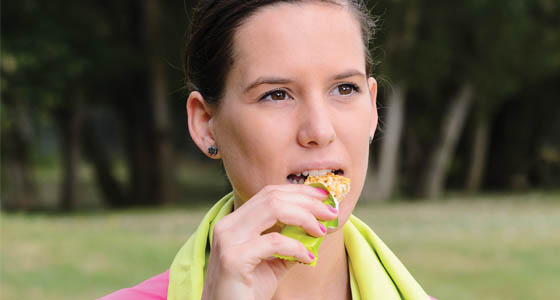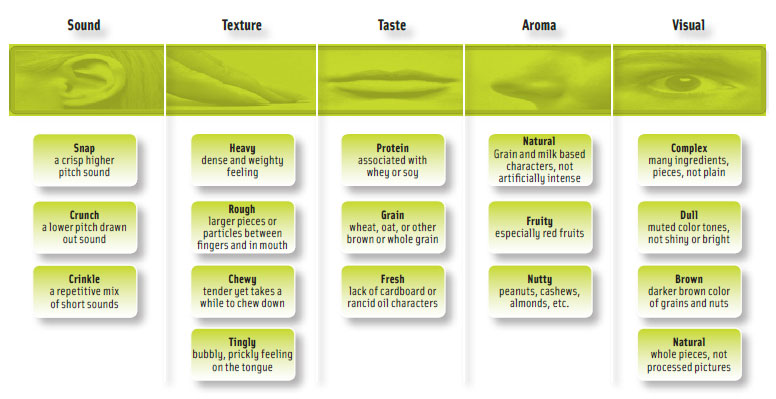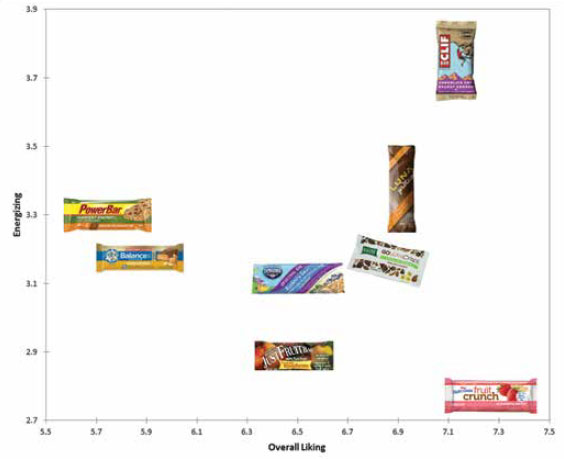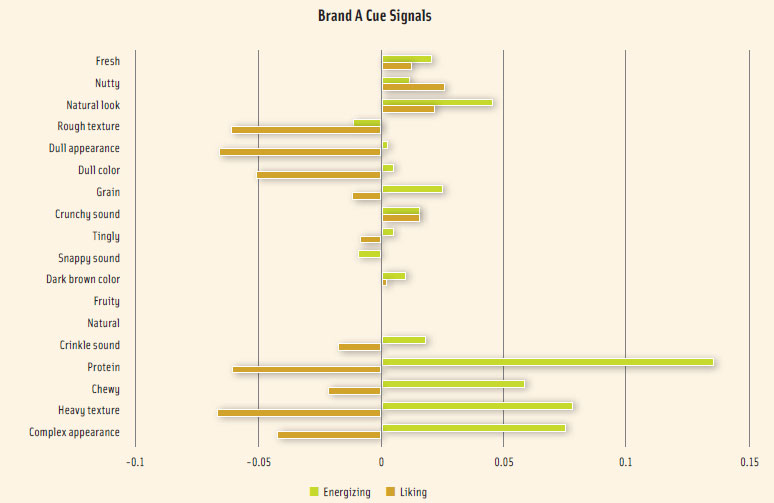New Insights on ‘Liking’ and Product Choice
Sensory research on energy bars reveals the need to design the right cues into products and packaging to signal benefits promised by the brand.

What is it about an energy bar that motivates consumers to purchase and/or use one brand over another? Is it the hedonic pleasure (the “liking”) of the taste and texture—or something else? We conducted sensory research to address this question and in the process uncovered some unexpected insights. Key finding: A consumer’s liking does not necessarily translate into choosing that product. As a matter of fact, consumers may choose products with attributes they like less.
These insights have implications for product developers, research chefs, consumer researchers, and food marketers. The relevance of these insights goes beyond the energy bar category. In fact, they highlight the importance of food product design and development incorporating research that goes beyond liking.
In a 2012 survey of the food industry, we found the biggest innovation challenge is translation—translating the benefits promised by a brand into a consumer product experience (Lundahl and Stucky, 2012). Underlying this challenge is the fact that the sensory qualities/features of a food package and/or product subconsciously communicate through cues what to expect about a product experience. These expectations impact how consumers react to product experiences during use, strengthening or weakening the formation of cues through conditioning. Cues are known to be a key motivator impacting consumer behavior. Recent research has linked sensory cues to satiety (Chambers et al., 2013) and habitual eating behavior (Neal et al., 2011).
This case study will highlight our approach and findings in identifying sensory cues motivating behavior within the energy bar category. The research approach behind the study can be used across any product category to guide product development, package design, and marketing to ensure your product communicates and fulfills key benefits relevant to consumers.
Case Study: Energy Bars
Energy bar manufacturers use a wide range of ingredients (e.g., protein, nuts, and fruit pieces) with differing sensory qualities (e.g., crunchy vs chewy, smooth vs rough, dull or light vs dark). Our research was focused on how to identify the sensory qualities that serve as cue signals about benefits sought within the energy bar category and to apply these insights to help marketers, product developers, and package designers go beyond liking in translating benefits into sensory qualities.
Our goal was to build a product guidance tool by applying the science of how cues motivate consumer behavior to build an energy bar more likely to deliver the benefits that consumers seek. We took a three-step approach to achieve this goal.
• First, we gained insight into what benefits consumers were “seeking” in their energy bar choices.
• We then discovered what “sensed” qualities about the bars were actually serving as “cues” to signal those respective benefits.
• Finally, we built a product guidance tool, specific for energy bars, which translates the benefits sought into a winning combination of sensed qualities that collectively signal those benefits.
The results prove the value of this approach. We were able to validate that some sensory qualities of energy bars are in fact cues that signal the presence or absence of benefits. Some qualities were found to be cues that translate into multiple signals, serving to enhance the perception of one benefit and detract from another—serving as a tradeoff cue.
--- PAGE BREAK ---
Moments of Consumption
Our first step was to understand the motivations of choice within moments of consumption where consumers are replacing a “regular meal.” Unlike needs, motivations are the underlying causes of behaviors specific to consumption moments. We were able to identify them by collecting information from 1,000 consumers (general representative U.S. population sample of adults) on three consecutive meal replacement moments and clustering these moments (i.e., usage occasions associated with activities in given contexts) on the basis of why product choices were made.
This approach identified seven meal replacement moments, each with a different set of motivations for product choice. They are:
1. Delicious Persevering
2. Busy Energizing
3. Programmed Dieting
4. Easy Eating
5. Trusting Nutrition
6. Maintaining Fitness
7. Tribe Dining
These moments provide the basis for going beyond liking, characterizing a broad set of motives for why choices were made. They also provided market-level insights by characterizing the consumer demographics of those typically in these moments. This enabled insights into what were the typical usage occasions of these moments and associated behaviors such as what is chosen to be consumed.
Energy bars were a frequent choice in “busy energizing” moments. These moments were further characterized to have a high proportion of Millennials, and occurred typically during breakfast or lunch meal replacement occasions. Choice of energy bars was motivated by a desire for sustained and convenient energy lasting until a next meal occasion. How well the product tasted was found to be less a motivator in driving choice.
Cues Signaling ‘Energizing’
The discovery that energy bars are frequently consumed during busy energizing moments was important in our second step. Step two was to identify product cues signaling “energizing” specific to busy energizing moments. We first focused the attention of research participants on their own busy energizing moments. In the context of these moments, we asked each participant to generate sensory metaphors associated with what was or was not energizing. This involved a set of exercises covering each of the five basis senses. A common set of food products were then rated by participants using their individual metaphors for energizing through a sensory technique called free association profiling.
--- PAGE BREAK ---
Table 1 shows the resulting list of cues came from each of the five senses.

Product Guidance Tool
To more effectively guide product or package design, we used the insights from step 1 and 2 to build a product guidance tool for energy bars.
We selected for our research eight energy bar brands which differed in design with regard to the presence or absence of sensory attributes identified to be cue signals for energizing. We selected products with nuts or fruit, having a chewy or crunchy texture, or a complex or dull appearance—all attributes which could act as cues of energizing. We asked consumers to not only rate their perceptions of energizing and liking, but also to check all the sensory qualities that apply (CATA) to characterize each product. The CATA attributes were the same as identified in step 2. Predictive models of energizing and “overall liking” from CATA ratings were generated for each research participant. These models validated that many of the attributes identified as cues in step 2 did in fact serve as signals for energizing and in some cases served as a signal that boosted or reduced overall liking scores.
Key Insights
This new approach yielded some counterintuitive findings about product attributes and how they signal benefits that are important to consumer choice:
• The construct of energizing is distinctively different from the construct of overall liking for energy bars. There was no correlation between energizing and overall liking ratings among the eight brands (see Figure 1).

• Market leaders Clif Bar and PowerBar were widely separated in terms of overall liking, but not energizing. This suggests energizing is more important than overall liking for the energy bars category within busy energizing moments.
• The presence of fruit signals “not energizing” in busy energizing moments. Fruit does serve as a cue signaling overall liking for some brands, such as NutriGrain Fruit Crunch.
• “Complex” and “dull” appearances, “heavy” and “chewy” textures, and “protein” flavor tended to be tradeoff cues signaling a product is energizing at the expense of overall liking.
• The appearance of nuts, the “crinkly” sound of the packaging, and “fresh” or “natural” appearances signal energizing and/or overall liking for different brands in the category.
This tool enabled us to offer recommendations for how each of these energy bars might be improved to boost consumer expectations and ratings for energizing and overall liking — motivating purchase and usage behaviors. For example, Figure 2 provides guidance in how increasing or decreasing the cue signals from sensory qualities of one of the brands serves to boost the overall liking score (9-point scale) without penalizing its energizing score (5-point scale), and vice versa. A positive value means it contributes to higher scores; a negative value means it contributes to lower scores.

With this information, we devised the following recommendations on how to improve Brand A:
• Increase the natural appearance to increase energizing, as it will not adversely impact overall liking.
• Decrease the rough texture, dull appearance, and color of the product to increase overall liking, as it will not adversely impact energizing.
• Take caution in increasing the protein flavor, chewy or heavy texture, or complex appearance, as it will likely increase the energizing perception of the product, but will reduce its overall liking.
--- PAGE BREAK ---
Building the Ideal Energy Bar
What does this mean? To build the perfect energy bar, you need to design into products and packaging the right cues to signal benefits promised by the brand. Furthermore, marketers need to ensure the positioning of a brand and its respective products can be translated into sensory qualities/features of products and packaging which serve as cues signaling important benefits. For example, if “sustained energy” is an important benefit for an energy bar, then it is essential the product design not include pieces of fruit.
This approach is growing in popularity as a way to not only guide product developers, but also to inspire research chefs and innovation team members working in the early stages of product development. These early stage translation decisions are critical to project success as they focus downstream research on specific product requirements for sensory qualities/features. This includes flavor and ingredient suppliers seeking to translate client briefs into winning business opportunities.
This technique has proven itself valuable to package designers as a way to identify the visual, tactile, and auditory cues from packaging, which are proving critical in the subconscious communication of the benefits promised by the brand.
Further, marketers are finding this approach of value to address line extension opportunities—identifying chief benefits sought as motivators of choice within moments where their brand is currently playing, and brand extension opportunities—identifying new moments to target as the biggest opportunity to grow their brand.
What is a Cue?
A perceived product quality or feature that signals a benefit or avoidance. Consumer motives often come from cues subconsciously sensed within the environment or from the product itself. Cues signal what to expect about an experience. Repeat experiences serve to strengthen or weaken cue signals through conditioning, leading to changes in behavior.
Want to Know More Firsthand?
David Lundahl, CE0, InsightsNow, Inc., will be presenting “Translating Healthy Food Benefits Into A Winning Product Combination: Strategies To Go Beyond Liking” at the upcoming Wellness 14 Conference, March 20–21, 2014, in downtown Chicago. The theme of Wellness 14 is “Developing and Marketing Healthy Snack Foods with Sensory Appeal.” In addition to general sessions, the conference is organized into three concurrent tracks—Sodium Reduction, Protein Enhancement, and Sugar Reduction. For more details and registration information, please visit http://www.ift.org/meetings-and-events/wellness.aspx or http://www.insightsnow.com/events/dave-lundahl-article-new-insights-on-Liking/.
David Lundahl, Ph.D.,
a professional member of IFT, is founder and CEO, InsightsNow, Inc., Corvallis, OR 97333 ([email protected]).
References
Chambers, L., Harvey, E., and Yeomans, M. 2013. Can the satiating power of a high energy beverage be improved by manipulating sensory characteristics and labeled information? Food Qual and Pref 28(1): 271-278.
Lundahl, D. and Stucky, G. 2012. eBook: 4 Biggest Innovation Challenges Unveiled. http://www.insightsnow.com/resources/publications/.
Neal, D., Wood, W., Wu, M., and Kurlander, D. 2011. The pull of the past: when do habits persist despite conflict with motives. Pers Soc Psychol Bull 37: 1428-1437.
